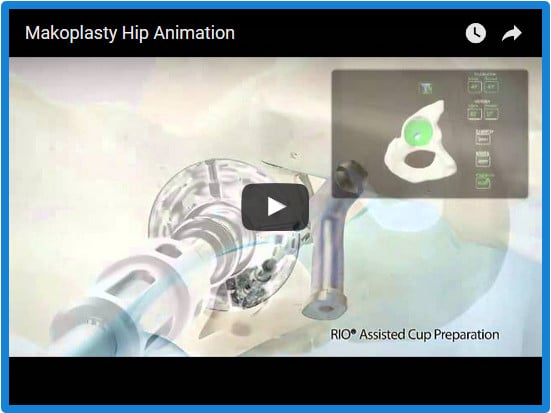The MAKOplasty® Total Hip Replacement is an alternative to traditional surgeries for adults who suffer from degenerative joint disease. It is a one of a kind, truly patient-specific procedure planned from the use of a 3-D model of the patient’s hip.
MAKOplasty® is enabled by the surgeon controlled RIO® Robotic Arm Interactive Orthopedic System, which allows your surgeon to achieve optimal and accurate placement of the implant allowing the patient to return to an active lifestyle.
Understanding Degenerative Joint Disease
The hip, a ball and socket joint, is one of the body’s largest weight-bearing joints. The ends of bones in this joint are covered by a layer of firm, elastic tissue known as cartilage that cushions the bones and also allows the easy, smooth movement of the joint. Does the question of what is degenerative joint disease of the hip pop into your mind? There are several types of DJD that are responsible for causing hip pain. These include but are not limited to:
- Osteoarthritis (OA): This is “wear and tear” arthritis and the most common type of hip arthritis. It stems from cartilage breaking down over time. As the protective cartilage breaks apart, bare bone is exposed causing bone-on-bone contact to occur.
- Post-traumatic arthritis: Hip dislocation or severe fractures of the hip can cause this type of arthritis
- Rheumatoid arthritis (RA): An inflammatory arthritis of the joints
- Avascular necrosis (AVN): If the femoral head, more commonly known as the “ball”, loses its healthy supply of blood flow, the bone will die causing the femoral head to become mis-shapen
- Hip dysplasia: A misalignment or developmental deformation of the hip joint.
Total Hip Replacement
What exactly does total hip replacement mean? Total hip replacement, also known as a total hip arthroplasty, is a surgical procedure where implants replace the ball-and-socket of the hip joint.
Examples of implants includes a metal cup with a plastic liner that is used to replace the socket in the pelvis and a ceramic or metal or head that is attached to a metal stem which is implanted into the femur. This implant replaces the ball of the joint.
The new cup and femoral head will provide a smooth bearing surface which allows smooth movement of the joint. When the cup and stem are implanted in the bone, it gives a surface that allows new bone to grow into the implant giving it permanent fixation
The utilization of robotics today is growing in the medical field and uses the best, cutting-edge technology available. Robotics in the medical field continues to advance with leaps and bounds developing rapidly.
The leading cause for integrating medical robotics into the health care system is to sanction for a greater sense of confidence in surgeons due to improved accuracy in surgical procedures, which is something that previously has not been achieved by just by human capabilities alone. Medical robotics is a valuable and unique integeration in the medical field because of the sense of accuracy.
With the use of robotics, surgeons and their team has great potential for maximizing time and capabilities while performing minor surgeries all the way the more complex surgical procedures. Medical robotics is a great way to improve surgery where there are strong needs for accuracy, precision and dexterity.
The first known documented use of robotics in any medical field occurred in 1985 making the use of medical robotics a new area in improvements in our health care system. During the first documented robotic use, a robot was able to aid in the placement of a needle, in the correct position, to be able to perform a biopsy of a patient’s brain.
Robotics will be a total change of all medical fields and surgical robots will soon be thought of as extra integrations in surgery due to the potential to increase the quality of the operation.





